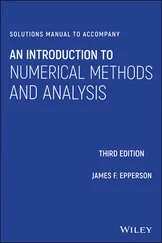(2.26) 
for the pressure ratio in the lower stratosphere. Finally, the density ratio in the lower stratosphere is simply found by the ideal gas law,
(2.27) 
Figure 2.4shows the pressure, density, and temperature distributions normalized by the sea level conditions in the standard atmosphere.
2.2.7 Comparison with Experimental Data
The above equations describe the idealized atmosphere where the parameters are considered as the mean values of the measured quantities. However, as indicated in The U.S. Standard Atmosphere (NOAA et al. 1976), measurement data show considerable variations of the atmospheric parameters depending on time (day and season) and geographic location, which should be considered in flight testing.
Experimental measurements may be compared with the theoretical variation of pressure and temperature derived from the standard atmosphere. Atmospheric data can be collected by a weather balloon ( Figure 2.5), which ascends through the atmosphere and measures pressure and temperature throughout the flight. For the case presented here, the balloon ascended to an altitude of 30.161 km (98,953 ft) before bursting and descending via parachute back to Earth. Data throughout the ascent and descent were collected and are presented in Figures 2.6and 2.7. The temperature data shown in Figure 2.6show similar trends to the standard temperature profile, but the agreement is not very good. This is not surprising, since the details of the temperature profile are strongly dependent on local weather, time of year, latitude, etc. However, some of the similarities are noteworthy: the experimental temperature lapse rate is approximately the same as the standard lapse rate, particularly at low altitudes. Also, the location of the tropopause, corresponding to a change to an isothermal temperature profile, is in good agreement. Finally, the slope of the high‐altitude lapse rate is also in fairly good agreement with the standard temperature profile. Pressure data, in Figure 2.7, show excellent agreement with the standard atmosphere. This is also expected since the hydrostatic equation is a good descriptor of the physics of pressure variation with altitude. The good agreement shown here underscores the utility of using pressure measurement for measuring altitude on aircraft (see Chapter 3for further details on how altimeters operate).

Figure 2.5 Launch of a high‐altitude weather balloon from the oval of The Ohio State University.

Figure 2.6 Comparison of the standard atmosphere with temperature data measured by a weather balloon.

Figure 2.7 Comparison of the standard atmosphere with pressure data measured by a weather balloon.
2.3 Altitudes Used in Aviation
We will now conclude this chapter with a discussion of different altitude definitions used in aviation. We have already introduced several definitions of altitude for the preceding discussion on the standard atmosphere. To recap, these include absolute altitude, geometric altitude, and geopotential altitude. Absolute altitude, h A, is measured from the center of the Earth and is only relevant when determining the value of gravitational acceleration at a particular altitude. Geometric altitude, h G, is the height of an aircraft above mean sea level. And, geopotential altitude, h , is the height above sea level with the assumption of constant gravitational acceleration. Geopotential altitude is only relevant in the context of deriving the standard atmosphere, so should not be used elsewhere. For the remainder of this book, we will presume that the differences between geometric altitude and geopotential altitude are small and will simply refer to the geometric altitude as h .
However, these altitude definitions are limited to an engineering context. To make things interesting, we also have a set of altitudes that are defined for the aviation community. And, to make things more interesting, some of the aviation altitudes use the same terms but different definitions! The aviation set of altitudes include true altitude, indicated altitude, pressure altitude, density altitude, and absolute altitude. We will discuss each of these as follows.
True altitude is the height above mean sea level. In the aviation community, this altitude is often abbreviated as MSL. When an aircraft altimeter is referenced to the local barometric pressure reading, it indicates true altitude. (Details on altimeter operation are provided in Chapter 3.) Pilots around the world often refer to this setting of the altimeter as QNH. Note that the aviation definition of true altitude is identical to the engineering definition of geometric altitude.
Similarly, indicated altitude is a direct reading from the altimeter, no matter how the altimeter is set. This may or may not be the same as true altitude, depending on the reference pressure used on the altimeter. (The reference pressure essentially shifts the calibration of the altimeter to match local barometric pressure, instead of standard sea level pressure.)
Pressure altitude, in the aviation realm, is defined as the altitude read from the altimeter when it is set to a reference pressure of 29.92 inHg, which is the standard sea level pressure. In many locations around the world, barometric pressure readings are reported in millibars or hPa, where 1013 mbar (=1013 hPa) is equal to 29.92 inHg (both being standard sea level pressure). Pilots refer to this setting of the altimeter – to provide pressure altitude – as QNE. In engineering terms, pressure altitude has essentially the same meaning. An engineer would express pressure altitude as the altitude corresponding to a given pressure in the standard atmosphere. Both the engineering and aviation definitions for pressure altitude are equivalent, since the altimeter referenced to 29.92 inHg (1013 mbar) is calibrated based on the standard atmosphere.
Density altitude is defined, in aviation terms, as the pressure altitude corrected for non‐standard temperature. If the temperature on a given day at a particular altitude is hotter than the standard temperature, then the density altitude will be higher. In engineering terms, density altitude is defined as the altitude corresponding to a given density in the standard atmosphere. Aircraft performance depends significantly on local air density, so density altitude is a direct indication of aircraft performance. Higher density altitude (corresponding to lower density) will lead to longer takeoff ground roll, slower rates of climb, higher true airspeed for stall, etc.
Finally, pilots are also concerned with the height of the aircraft above the local terrain, which is termed absolute altitude. In the aviation realm, absolute altitude is often also termed height above ground level, so the acronym AGL is often used. On aviation charts, both true altitude (MSL) and absolute altitude (AGL) are reported for various obstacles. For example, the top of a 500‐ft tall radio tower mounted on ground that is 1500 ft above sea level will have a maximum height of 2000 ft MSL or 500 ft AGL. Thus, pilots pay close attention to the absolute altitude (also referred to as QFE) as well as the true altitude (QNH). Note that absolute altitude (AGL) in an aviation context is not the same as absolute altitude ( h A) in an engineering context. The engineering definition of absolute altitude is seldom used in aerospace or aviation, outside of discussions of the standard atmosphere.
Читать дальше

















